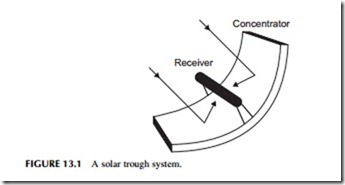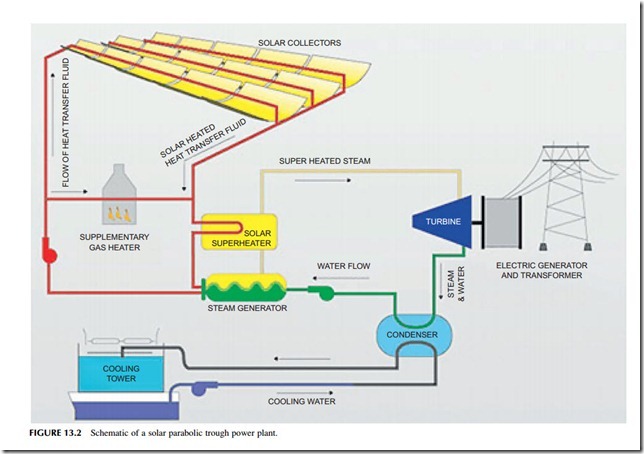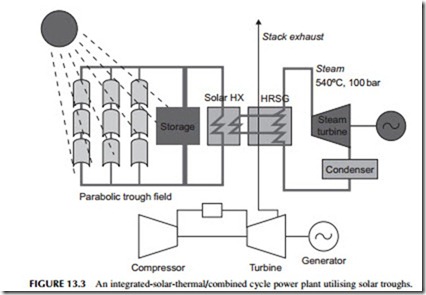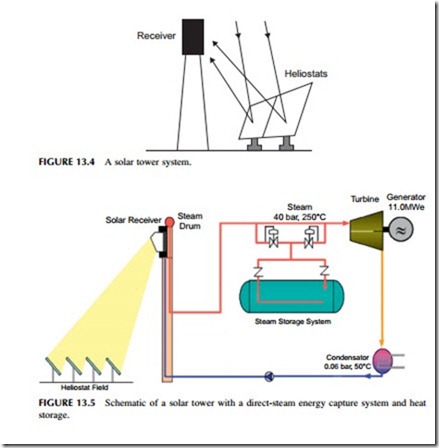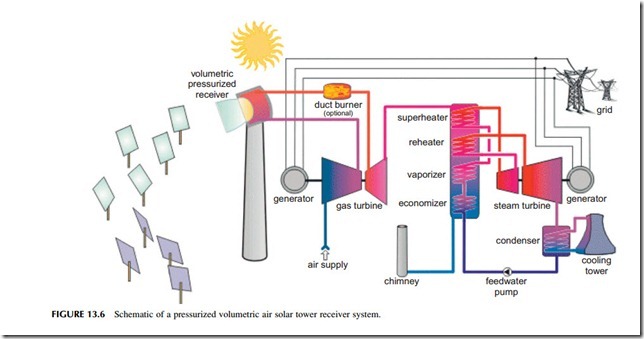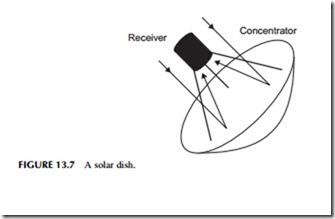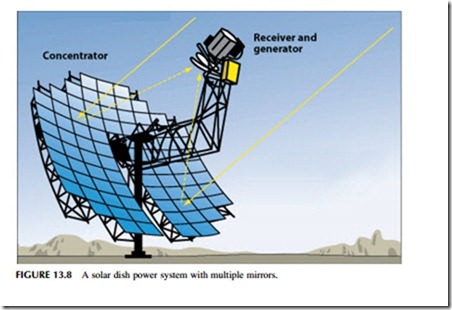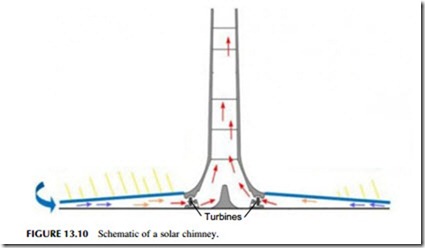SOLAR THERMAL POWER GENERATION
Solar thermal power generation uses the sun simply as a source of heat. As dis- cussed before, the energy reaching Earth’s surface is mostly either infrared or visible radiation. A solar thermal plant can utilize the infrared and a small part of the visible spectrum. This energy is absorbed and used to raise the temperature of a heat-transfer fluid while the remainder is rejected.
The solar radiation as it reaches Earth is of relatively low intensity and it must be concentrated to be an effective source of heat. In solar thermal power plants this is carried out by the use of mirrors with the type of mirror defining the solar thermal power plant. Three types are in common use: a parabolic trough reflector, solar tower power plant, and parabolic dish solar power plant. A fourth type uses a Fresnel lens that approximates to a parabolic trough reflector.
There are two other types of solar thermal power plant. One is a solar pond, a large area of water exposed to sunlight that is designed to maintain a small tem- perature gradient between its upper and lower layers that can be used to drive a heat engine. This is a relatively low-technology solar thermal plant and it has been rarely used. The second, called a solar chimney, has only been tested at very small scale and never deployed commercially. The idea behind it is to exploit the heating of air by the sun to generate an updraft in a very tall chimney. Wind turbines are then placed within the chimney and their rotation generates electricity.
Parabolic Troughs
The sunlight that reaches Earth, while it can feel extremely hot, does not contain sufficient energy in the diffuse form in which it arrives to constitute the basis for a thermal power generation system. To make it useful, the sunlight from a large area must be concentrated. This can be achieved with a magnifying lens, but lenses form a relatively expensive way of concentrating sunlight. Much better is a concentrating reflector.
The parabola is the ideal shape for a solar reflector because it concentrates all the light incident on it from the sun at a single point called the focus. A complete parabola is circular; this forms the basis for a solar dish system (see later). However, there is a limit to the size of dish that can be built. For large-scale solar concentration, a trough-shaped reflector has proved more effective. If the trough is built with a parabolic cross-section, the reflector will bring the incident sunlight to focus at a line rather than at a single point—that is, a line running along the length of the trough (Figure 13.1). A heat absorption system is then
placed along the length of the trough at its focus. This is the basis for the solar trough, sometimes called a line-focusing solar thermal power plant.
Parabolic troughs are the oldest solar thermal technology and were first used for a plant built near Cairo in 1912 to generate steam that drove a steam engine pump. The earliest modern electricity-generating plants of this type were built in California in the 1980s and early 1990s, and nine plants are still operating. However, the economics of solar thermal technology were marginal at that time and it was not until the first decade of this century that further plants of were built.
The key element of a parabolic trough solar plant is the reflecting trough itself. These have traditionally been manufactured from 4 mm glass that is hot-formed into the required parabolic shape in a special bending plant and then mirrored. A typical trough will be up to 5–6 m wide (this is called its aperture) and will be made from individual sections up to 20 m in length that are used to build troughs up to 150 m in length. These are then mounted onto a tubular steel frame and fitted with a tracking system that enables them to track the sun across the sky. The long axis of each trough is aligned north to south so that they can rotate to track the sun from east to west. A typical 50 MW parabolic trough solar thermal plant will have 600 individual troughs and a total reflector area of around 500,000 m2.
The cost of the reflector is the single-most important capital cost element of a parabolic trough plant, so ways of reducing costs are attracting attention. Some developers are using polymer troughs that are cheaper than glass, and lighter, but their reflection efficiency and durability are not generally as good as that of glass. Aluminum-alloy mirrors have also been used.
The heat concentrated in the parabolic trough is collected using a pipe running along the length of each mirror, at its focus, and containing a heat-transfer fluid that is pumped along the pipe. This pipe will generally be made from steel to which a special coating has been applied to maximize the heat absorption. A single heat collection pipe will run through several 150 m long mirrors to enable the heat-transfer fluid to reach a high enough temperature for power generation. These individual heat-transfer pipes are then connected in parallel in the heat collection circuit.
A parabolic reflector can concentrate sunlight between 60 and 100 times (the concentration ratio) and this is capable of raising the temperature of the heat- transfer fluid to a much as 550 oC. However, the actual temperature is often limited by the heat-transfer fluid, usually synthetic oil, which must be kept below 400o to prevent it from decomposing. For a typical plant of this type the heat- transfer fluid enters the solar field at 290 oC and leaves at 390 oC.
To generate electricity from sunlight, the heat contained within the heat- transfer fluid is used to raise steam to drive a steam turbine (Figure 13.2). This is carried out by passing it through a series of heat exchangers. Modern plants often use a reheat steam turbine that has two turbine sections with the steam heated again when it exits the first section and before entering the second section.
This is usually more efficient than using a single-stage turbine. A recent 50 MW plant in Spain used a 50 MW reheat steam turbine with steam conditions of 370 oC and 100 bar.
Some plants also use supplementary heating provided by natural gas to both improve their reliability during variable sunlight conditions and to extend the range of operation into the early morning and late evening. Sunlight collection efficiency is around 75% but the low temperature of the heat-transfer fluid makes the turbine cycle relatively inefficient, at around 38%. Overall efficiency is generally 15–16%.
The operation of a parabolic trough plant can be improved by adding a heat storage facility. With this, the plant can operate for longer each day. It is not considered efficient to store the heat-transfer fluid itself, so plants that adopt this configuration usually use an alternative heat storage medium. The most common is molten salt, usually a mixture of nitrates, that can operate up to 600 oC.
A heat storage system comprises two tanks, one containing hot heat storage fluid and the other cold fluid (or relatively cold, for it will still be at around 300 oC to maintain it in the liquid state). To store energy, molten salt is taken from the colder tank and heated using the heat-transfer fluid then stored in the hot tank. To extract energy again the cycle is reversed with salt from the hot tank used to raise steam for power generation before being returned to the cold tank. With storage, the capacity factor of a solar thermal plant of this type can be raised from around 20–30% to 60%.
The amount of energy that can be stored will depend on the generating capacity of the plant and the size of the solar field. The larger the solar field relative to the size of the plant turbine, the more energy can be stored. However, since the solar field is the single-most expensive part of the plant, the economics of storage need to be weighed carefully. In principle, a plant could be designed to operate 24 hours each day, but generally they are designed to be capable of supplying power during the main periods of grid demand rather than continuously.
Since 2007 a number of commercial solar trough power plants have been built. The largest concentration of these is in Spain. Many of these installations are around 50 MW in generating capacity and a number include some form of energy storage. Larger-capacity plants have been proposed, particularly in the United States, but these have not yet been built.
In addition to the standard parabolic trough plant it is possible to build a hybrid solar fossil fuel power plant using trough technology (Figure 13.3). Such plants are based on a natural gas–fired combined cycle power plant but with an additional solar collection field. In this type of plant natural gas is burned in the gas turbine to generate power and then the exhaust gases are fed into a heat- recovery steam generator to provide steam, but with the steam production boosted during sunlight hours by heat from the solar field. These plants are normally called integrated solar combined cycle or ISCC plants. Many of the ISCC
plants that have been constructed are in North Africa or the Middle East where both cheap natural gas and abundant sunlight are available, but the configuration can be exploited in many parts of the world.
Although most parabolic trough power plants use a synthetic oil as the heat-transfer fluid, the efficiency of the plants could be increased by using a direct- steam cycle. This would involve doing away with the heat-transfer fluid and heating water to generate steam directly within the parabolic trough heat col- lection and transfer circuit. While this presents some engineering problems, it would allow much higher steam operating conditions to be achieved, leading to higher heat engine efficiency. Direct-steam technology is being actively developed by several companies and research organizations. Another area that could add to performance would be the use of concrete for energy storage. Concrete would offer a much cheaper option than molten salt because it can store heat at a higher temperature, allowing smaller stores to be built as well as enabling a higher thermodynamic efficiency to be achieved.
Solar Towers
The solar tower takes a slightly different approach to solar thermal power generation. Whereas the parabolic trough array uses a heat collection system spread throughout the solar array, the solar tower concentrates heat collection at a sin- gle central facility. The central facility includes a large solar energy receiver and heat collector that is fitted to the top of a tower. The tower is positioned in the center of a field of special mirrors called heliostats, each of which is con- trolled to focus the sunlight that reaches it onto the tower-mounted solar receiver. This type of solar thermal plant is referred to as a point-focusing solar thermal plant (Figure 13.4).
The earliest solar tower was a 500 kW test rig constructed in Spain in 1981. It used liquid sodium as its heat-transfer medium (similar to some types of experimental nuclear reactor). In 1982 a project called Solar 1 was built at Bar- stow in California with a generating capacity of 10 MW based on a water/steam heat-transfer cycle. Solar 1 was upgraded to Solar 2 in 1996 and used molten salt to absorb and transfer the heat. Tests were carried out elsewhere too, but it was not until 2007 that the first commercial solar tower project, called Planta Solar 10 (PS10), began operating in Spain. The technology remains less well devel- oped than solar trough technology.
The solar tower power plant is essentially an approximation of a massive parabolic dish, with a typical layout shown in Figure 13.5. The mirrors that
make up its solar field are all parabolic reflectors that concentrate sunlight to a focus at the top of the central tower. However, each ring of reflectors belongs to a parabola of slightly different size. Each mirror must be able to track the sun independently, making the solar collection system relatively more expensive than for a solar trough plant. The advantage is that a higher temperature can be achieved in this type of plant. A concentration factor between 600 times and 1000 times is possible, allowing temperatures between 800 oC and 1000 oC to be reached. Existing plants have only achieved 600 oC, but even so this provides a 20% increase in efficiency in the steam cycle over a solar trough plant using a synthetic-oil heat-transfer fluid.
The maximum size of a solar tower power plant is determined by the size of the solar field that can be built. This will be limited because once the distance from the heliostat to the central receiver becomes too large, efficiency will drop. It appears likely that the largest single field tower will be around 200 MW or less. Larger plants will have to be based on multiple fields and towers.
The mirrors, or heliostats, used in a solar tower field are almost flat and this helps make them cheaper to manufacture than solar troughs. The nature of the solar tower means that flat terrain is not necessary either to build the plant. For a solar trough plant a flat site is essential. Heliostats are typically up to 120 m2 in area. The 11 MW PS10 plant in Spain has 624, occupying an area of 60 ha or 5.5 ha/MW. A second Spanish plant, PS20 with 20 MW capacity, has 1255 heliostats covering an area of 90 ha.
Both or these Spanish solar towers use a direct-steam system to capture heat and generate steam. The steam conditions are relatively low at 250 oC and 40 bar and this limits the overall efficiency of the plants. Steam storage tanks are also used to extend the operating range of each plant but this is only suitable for short-term storage and operation is limited to the hours of sunlight.
An alternative approach is to use a molten salt as the heat absorption and transfer fluid. This was the approach used in the demonstration Solar 2 project in California during the 1990s. Such an approach also lends itself to heat storage since the molten salt can be stored hot in a cycle similar to that outlined earlier for heat storage with a parabolic trough plant. Hot salt is then taken from the storage tank and passed through heat exchangers to generate steam before being stored again in the cold tank. Though more expensive than a direct-steam plant, the molten salt storage system allows the plant to operate for much longer because of its higher storage capability.
There is a third design for a solar tower that could potentially offer even bet- ter performance by using air as the heat-transfer fluid. This is the basis of the volumetric air receiver, built from ceramics and capable of heating air to 1000 oC (Figure 13.6). In the simplest air system, the air is passed through heat exchangers and used to generate steam to drive a turbine. However, a more advanced cycle uses pressurized air that can be used to drive a gas turbine, once heated. The hot air exiting the gas turbine is then used to generate steam for a steam turbine in a cycle similar to the combined cycle power plant. An air cycle
is not easily adapted for energy storage but can be fitted with supplementary natural gas firing if necessary.
Spain is the location for the largest solar towers in operation today. These include the PS20 20 MW plant and the Gemasolar plant with a generating capacity of 19.9 MW. The latter, which began operating in 2011, uses a molten-salt heat-transfer fluid and is sized so that it can provide power for up to 15 hours each day without the need for sunlight. This allows it to claim 24-hour operation. Overall plant efficiency is estimated to be 15% and the plant has a capacity factor of 65%. A much larger project is under construction at Ivanpah in California. This plant will comprise three facilities with a combined generating capacity of 377 MW. Each facility will have several towers, with the individual tower size expected to be 33––50 MW. These are based on a direct- steam cycle with steam conditions of 550 oC and 160 bar. The first unit started delivering power to the grid in 2013 from the first of three towers. These plants require 3.4 ha/MW.
Solar Dishes
A solar dish power plant is typically a single parabolic reflector similar to a satellite antenna but with a heat engine instead of a microwave receiver at its focus (Figure 13.7). The dish and its engine are constructed as a single unit, mounted on a framework that will allow it to track the sun across the sky. Most solar dish power units are 25 kW or less though bigger ones have been built. Deployed singly, they can provide a self-contained power supply unit. However, they can also be deployed in larger numbers to provide higher generating capacity.
Most solar dishes use simple self-contained heat engines to generate power, but in one or two recent projects solar dish systems have been designed to provide steam for a steam turbine. The main advantages of solar dishes are their simplicity and efficiency. Single solar dishes are capable of achieving 30% energy conversion efficiency, much higher than any of the other solar thermal technologies.
The first solar dish energy devices were built by the French mathematician August Mouchet in the 19th century to drive a steam engine. The modern version, designed for power generation, began to appear after the 1970’s energy crises. However, the technology has struggled to prove itself economically and it was only at the end of the first decade of the 21st century that a demonstration project involving a large array of solar dishes finally started generating power.
The solar dish can be considered to be a solar tower in miniature, a point focusing solar thermal system with a high concentration ratio. With its single, continuous reflector a solar dish can achieve a concentration ratio of 2000. This allows a very high temperature up to 1000 oC to be achieved, allowing high energy conversion efficiency. The heat engine at the center of a dish is matched to the heat input, with a 10 m diameter dish capable of supplying around 25 kW of electrical power with a direct solar insolation of 1000 W/m2. Units capable of providing up to 100 kW have been built, but at larger sizes the dishes become massive and difficult to manage.
As with other types of solar thermal power plants the reflectors for solar dishes are generally made from mirrored glass (Figure 13.8). However, a single 10 m diameter glass reflector would be prohibitively expensive (and heavy) so they are usually made up from an array of small elements that approximate the large dish. Plastic and aluminum reflectors have also been tested, as well as a novel technique in which a thin plastic membrane is pulled taut over a hoop and then deformed by applying a partial vacuum to one side of it.
To achieve high efficiency, a solar dish must track the sun accurately. For larger dishes this is usually achieved by tracking on two perpendicular axes. For smaller dishes polar tracking is often deployed. This involves rotating the dish about an axis parallel to Earth’s axis of rotation at 15o/hour to match the speed Earth’s rotation. Movement about a second axis is often used to take account of the seasonal movement of the sun in the sky.
The generation of electricity with a solar dish is normally carried out with a small self-contained engine, usually either a Stirling engine or a micro-turbine fixed at its focus. In both cases the heat at the focus of the dish is used to heat a thermodynamic fluid that drives the engine, generating power. In a Stirling engine that fluid is hydrogen or helium held within the engine in a closed cycle. With a micro-turbine the thermodynamic fluid is air and the cycle is that of a gas turbine cycle. The Stirling engine is capable of very high efficiency and, although operating engines in solar dishes have only achieved just over 31% efficiency, 40% may be feasible. The micro-turbine is less efficient, with a potential efficiency around 30%, but they are cheaper. In addition, the heat input into the micro-turbine can be boosted with natural gas if necessary. That is less easy to achieve with the Stirling engine, which has a completely closed cycle.
It is possible to build a solar dish that can use the heat it collects to generate steam for a steam turbine. To make this effective it will normally be necessary either to construct one very large dish or build a series of smaller dishes connected to a single heat circuit. Dish systems based on a steam cycle have been developed by the Australian National University.
The commercialization of solar dish technology has been slow. The first semi-commercial project, the Maricopa power plant in Phoenix, Arizona, entered service in 2010. The plant has 60 parabolic dishes with an aggregate generating capacity of 1.5 MW. Its construction was supported by the U.S. government. A project of similar capacity at the Tooele Army Base in Utah began testing in the middle of 2013. Much larger schemes have been proposed in California.
Fresnel Reflectors
The Fresnel reflector represents an attempt to reduce the cost of solar thermal technology by creating a cheap heat collection system. In this case the model is the parabolic trough. However, instead of a single parabolic trough, the Fresnel system employs a series of long, almost flat reflectors that approximate the trough. Each individual reflector is mounted so that it can track the sun and the energy it collects is focused onto a stationary pipe above the reflectors running the length of the trough. Figure 13.9 provides a typical layout.
The earliest solar thermal plant based on Fresnel reflectors was developed by an Italian, Giovanni Francia, who patented the system in 1962 and built a prototype in France in 1964. Further development took place in Australia in the 1990s where a large demonstration scheme was constructed, and since then plants have been built in the United States and in southern Spain.
The Fresnel system bears some similarity to the solar tower approach with a series of flat reflectors approximating the parabolic reflector, although in this case the reflector it mimics is a trough. Like the tower, these reflectors can be mounted close to the ground, simplifying construction and increasing stability while the reflector and heat collector are separated, making the design simpler. The refl- ectors are long and either flat or slightly curved, with around 20 replacing a single trough. As with a trough, each reflector is made of around six individual segments. They are usually made from glass but other materials are possible. Collection efficiency is lower than for a parabolic trough, with a concentration ratio of between 30 and 50 typical.
Fresnel power plants usually use direct-steam generation to improve effi- ciency and reduce costs. They are claimed to have smaller space requirements than traditional trough plants with around 1.3 ha/MW. One of the largest oper- ating plants is the Augustin Fresnel 1 plant in France with a generating capacity of 250 MW. This plant uses water as the heat-transfer fluid, the latter exiting the heat collection field at 300 oC. The turbine operating pressure is 100 bar. The plant began generating power for the grid in 2012.
Other Solar Thermal Technologies
The solar chimney (sometimes confusing since also called a solar tower) uses heat from the sun to raise the temperature of an enclosed volume of air, creating a pressure that can be used to produce an updraft in a tall chimney. Turbines within the chimney can then generate electricity.
To make this feasible, a large circular greenhouse must be constructed to capture heat and raise the temperature of the air enclosed within it, as shown in Figure 13.10. The outer edges of the greenhouse are open so that air can be drawn in. Meanwhile, at the center of the circle rises a tall chimney. The hot air within the greenhouse is drawn toward and up this chimney, creating an air flow that can be exploited by wind turbines to produce electricity.
Although the idea for a solar tower was published as early as 1903 by a Span- iard, Isidoro Cabanyes, the first to be built was constructed in 1981 in southern Spain by a German company. This had a 180 m high, 12 m diameter tower and housed a single 50 kW turbine to test to principle. The project operated until 1989. The concept has since been adopted by a U.S. company that has put for- ward plans to build a major plant of 100–200 MW but no plant has yet been constructed. In 2010 a 200 kW tower started operating in Inner Mongolia. There are plans to expand this Chinese development to around 27 MW.
A solar pond is also a relatively old idea that has rarely been exploited. It consists of a shallow pond, usually between one and two meters in depth, filled with brine and covered with some form of membrane to prevent evaporation (Figure 13.11). When sunlight heats the brine it creates a layer of hot, concentrated brine at the bottom of the pond. As a consequence of its density the brine remains at the bottom of the pond even though it is hotter than the water above it.
The hot brine can reach 70–80 oC while the upper layer will be between 20 oC and 30 oC, creating a temperature gradient that can be used to drive a small heat engine. This is usually a small organic Rankine cycle turbine that can extract energy from such a tiny temperature difference. The technology was tested in Israel during the 1980s when a 5 MW project was built in the Dead Sea region, but it does not appear to have been pursued, either there or elsewhere.
